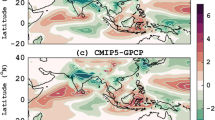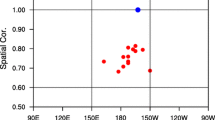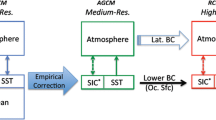Abstract
The Mediterranean region is identified as one of the two main hot-spots of climate change and also known to have the highest concentration of cyclones in the world. These atmospheric features contribute significantly to the regional climate but they are not reproduced by the Atmosphere–Ocean General Circulation Models (AOGCM), due to their coarse horizontal resolution, which have recently been run in the frame of the 5th Climate Model Intercomparison Project. This article investigates the benefit of dynamically downscaling the Institut Pierre Simon Laplace (IPSL) AOGCM (IPSL-CM5) historical simulation by the weather and research forecasting (WRF) for the representation of the Mediterranean surface winds and cyclonic activity. Indeed, when considering IPSL-CM5 atmospheric fields, the dramatic underestimation of the cyclonic activity in the most cyclogenetic region of the world jeopardizes our ability to investigate in-depth the Mediterranean regional climate and trend in the context of global change. The WRF model shows remarkable skill to reproduce regional cyclogenesis. Indeed, cyclones occurrence is quasi-absent in IPSL-CM5 data but when applying dynamical downscaling their spatial–temporal variability is very close to the re-analysis. This is a clear benefit of dynamical downscaling in regions of strong topographic forcing. This “steady” source of forcing allows the production of lee cyclogenesis and the development of strong cyclones, whatever the quality of the large-scale circulation provided at the WRF’s boundaries by IPSL-CM5. However, dynamical downscaling still presents disadvantages as for instance the fact that large-scale inaccurate features of the IPSL-CM5 regional circulation are replicated by WRF due to the boundary controlled (small domain) simulation. The advantages and disadvantages of dynamical downscaling are thoroughly discussed in this paper revealing its importance for climate research, especially in the context of future scenarios and wind impacts.











Similar content being viewed by others
References
Alpert P, Ben-Gai T, Baharad A, Benjamini Y, Yekutieli D, Colacino M, Diodato L, Ramis C, Homar V, Romero R, Michaelides S, Manes A (2002) The paradoxical increase of Mediterranean extreme daily rainfall in spite of decrease in total values. Geophys Res Lett 29:311–314
Arreola JL, Homar V, Romero R, Ramis C, Alonso S (2002) Multiscale numerical study of the 10–12 November 2001 strong cyclogenesis event in the western Mediterranean. In: Proceedings of the 4th EGS Plinius conference held at Mallorca, Spain, October 2002
Buzzi A, D’Isidoro M, Davolio S (2003) A case study of an orographic cyclone south of the Alps during the MAP SOP. Q J Royal Meteorol Soc. 129:1795–1818
Dee DP, Uppala S (2009) Variational bias correction of satellite radiance data in the ERA-Interim reanalysis. QJR Meteorol Soc 135:1830–1841
Drobinski P, Flamant C, Dusek J, Flamant PH, Pelon J (2001) Observational evidence and modeling of an internal hydraulic jump at the atmospheric boundary layer top during a tramontane event. Boundary Layer Meteorol 98:497–515
Drobinski P, Bastin S, Guénard V, Caccia JL, Dabas AM, Delville P, Protat A, Reitebuch O, Werner C (2005) Summer mistral at the exit of the Rhône valley. Q J R Meteorol Soc 131:353–375
Drobinski P, Ducrocq V, Lionello P, the HyMeX ISSC (2009a) HyMeX, a potential new CEOP RHP in the Mediterranean basin. GEWEX Newsl 19:5–6
Drobinski P, Béranger K, Ducrocq V, Allen JT, Chronis G, Font J, Madec G, Papathanassiou E, Pinardi N, Sammari C, Taupier-Letage I (2009b) The HyMeX (Hydrological cycle in the Mediterranean Experiment) program: the specific context of oceanography. MERCATOR Newsl 32:3–4
Drobinski P, Ducrocq V, Lionello P (2010) Studying the hydrological cycle in the Mediterranean, EOS. Trans Am Geophys Union 91:373
Drobinski P, Anav A, Lebeaupin-Brossier C, Samson G, Stéfanon M, Bastin S, Baklouti M, Béranger K, Beuvier J, Bourdallé-Badie R, Coquart L, D’Andrea F, De Noblet-Ducoudré N, Diaz F, Dutay JC, Ethe C, Foujols MA, Khvorostiyanov D, Madec G, Mancip M, Masson S, Menut L, Palmieri J, Polcher J, Turquety S, Valcke S, Viovy N (2011a) Model of the regional coupled Earth system (MORCE): application to process and climate studies in vulnerable regions. Environ Model Softw, submitted
Drobinski P, Ducrocq V, Lionello P, Homar V (2011b) HyMeX, the newest GEWEX regional hydroclimate project. GEWEX Newsl 21:10–11
Fichefet T, Morales-Maqueda A (1999) Modelling the influence of snow accumulation and snow-ice formation on the seasonal cycle of the Antarctic sea-ice cover. Clim Dyn 15(4):251–268
Fita L, Romero R, Luque A, Emanuel K, Ramis C (2007) Analysis of the environments of seven Mediterranean tropical-like storms using an axisymmetric, nonhydrostatic, cloud resolving model. Nat Hazards Earth Syst Sci 7:41–56
Flaounas E, Janicot S, Bastin S, Roca R, Mohino E (2011) The role of the Indian monsoon onset in the West African monsoon onset: observations and AGCM nudged simulations. Clim Dyn. doi:10.1007/s00382-011-1045-x
Flocas HA, Maheras P, Karacostas TS, Patrikas I, Anagnostopoulou C (2001) A 40-year climatological study of relative vorticity distribution over the Mediterranean. Int J Climatol 21:1759–1778
Gaertner MA, Jacob D, Gil V, Domínguez M, Padorno E, Sánchez E, Castro M (2007) Tropical cyclones over the Mediterranean Sea in climate change simulations. Geophys Res Lett 34:L14711. doi:10.1029/2007GL029977
Giorgi F (2006) Climate change hot-spots. Geophys Res Lett 33:L08707. doi:10.1029/2006GL025734
Giorgi F, Jones C, Asrar GR (2006) Adressing climate information needs at the regional level: the CORDEX framework. WMO Bull 58:175–183
Hong SY, Pan HL (1996) Non-local boundary layer vertical diffusion in medium-range forecast model. Mon Weather Rev 124:1215–1238
Hoskins BJ, Hodges KI (2002) New perspectives on the Northern Hemisphere winter storm tracks. J Atmos Sci 59:1041–1061
Hourdin F, Musat I, Bony S, Braconnot P, Codron F, Dufresne J, Fairhead L, Filiberti M, Friedlingstein P, Grandpeix J, Krinner G, Levan P, Li Z, Lott F (2006) The LMDZ4 general circulation model: climate performance and sensitivity to parametrized physics with emphasis on tropical convection. Clim Dyn 27:787–813
Hourdin F, Grandpeix J-Y, Rio C, Bony S, Jam A, Cheruy F, Rochetin N, Fairhead L, Idelkadi A, Musat I, Dufresne J-L, Lahellec A, Lefebvre M-P, Roehrig R (2012) LMDZ5B: the atmospheric component of the IPSL climate model with revisited parameterizations for clouds and convection. Clim Dyn. doi:10.1007/s00382-012-1343-y
Kain JS (2004) The Kain–Fritsch convective parameterization: an update. J Appl Meteorol 43:170–181
Krinner G, Viovy N, de Noblet-Ducoudre N, Ogee J, Polcher J, Friedlingstein P, Ciais P, Sitch S, Prentice I (2005) A dynamic global vegetation model for studies of the coupled atmosphere-biosphere system, Glob Biogeochem Cycle 19. doi:10.1029/2003GB002199
Lagouvardos K, Kotroni V, Defer E (2007) The 21–22 January 2004 explosive cyclogenesis over the Aegean Sea: observations and model analysis. Q J Royal Meteorol Soc 133:1519–1531
Lavaysse C, Vrac M, Drobinski P, Lengaigne M, Vischel T (2011) Statistical downscaling of the French Mediterranean climate: assessment for present and projection in an anthropogenic scenario. Nat Hazards Earth Syst Sci, submitted
Lebeaupin C, Ducrocq V, Giordani H (2006) Sensitivity of Mediterranean torrential rain events to the sea surface temperature based on high-resolution numerical forecasts. J Geophys Res 111:D12110. doi:10.1029/2005JD006541
Lebeaupin-Brossier C, Drobinski P (2009) Numerical high-resolution air-sea coupling over the Gulf of Lions during two tramontane/Mistral events. J Geophys Res 114:D10110. doi:10.1029/2008JD011601
Lionello P, Boldrin U, Giorgi F (2007) Future changes in cyclone climatology over Europe as inferred from a regional climate simulation. Clim Dyn 30:657–671. doi:10.1007/s00382-007-0315-0
Madec G, Delecluse P, Imbard M, Levy C (1997) Ocean general circulation model reference manual, 3. LODYC, Technical Report, p 91
Maheras P, Flocas H, Patrikas I, Anagnostopoulou C (2001) A 40 year objective climatology of surface cyclones in the Mediterranean region: spatial and temporal distribution. Int J Climatol 21:109–130
Marti O, Braconnot P, Dufresne J, Bellier J, Benshila R, Bony S, Brockmann P, Cadule P, Caubel A, Codron F, de Noblet N, Denvil S, Fairhead L, Fichefet T, Foujols MA, Friedling-stein P, Goosse H, Grandpeix JY, Guilyardi E, Hourdin F, Idelkadi A, Kageyama M, Krinner G, Levy C, Madec G, Mignot J, Musat I, Swingedouw D, Talandier C (2010) Key features of the IPSL ocean atmosphere model and its sensitivity to atmospheric resolution. Clim Dyn 34(1):1–26. doi:10.1007/s00382-009-0640-6
Meneguzzo F, Pasqui M, Messeri G, Rossi M (2000) High-resolution simulation of a deep Mediterranean cyclone using RAMS model. In: Proceedings of second EGS Plinius conference on Mediterranean storms, Siena, Italy, EGS, pp 225–235
Mlawer EJ, Taubman SJ, Brown PD, Iacono MJ, Clough SA (1997) Radiative transfer for inhomogeneous atmosphere: RRTM, a validated correlated-k model for the longwave. J Geophys Res 102(D14):16663–16682
Musculus M, Jacob D (2005) Tracking cyclones in regional model data: the future of Mediterranean storms. Adv Geosci 2:13–19
Nasr-Esfahany MA, Ahmadi-Givi F, Mohebalhojeh AR (2011) An energetic view of the relation between the Mediterranean storm track and the North Atlantic Oscillation. QJR Meteorol Soc. doi:10.1002/qj.794
Omrani H, Drobinski P, Dubos T (2011) Investigation of indiscriminate nudging and predictability in a nested quasi-geostrophic model. Q.J.R. Meteorol Soc. doi:10.1002/qj.907
Petterssen S (1956) Weather analysis and forecasting. McGraw-Hill, New York 428
Pirazzoli PA, Tomasin A (2003) Recent near-surface wind changes in the central Mediterranean and Adriatic areas. Int J Climatol 23:963–973
Poupkou A, Zanis P, Nastos P, Papanastasiou D, Melas D, Tourpali K, Zerefos C (2010) Present climate trend analysis of the Etesian winds in the Aegean Sea. Theoret Appl Climatol. doi:10.1007/s00704-011-0443-7
Reddaway JM, Bigg GR (1996) Climatic change over the Mediterranean and links to the more general atmospheric circulation. Int J Climatol 16:651–661
Romero R (2001) Sensitivity of a heavy rain producing Western Mediterranean cyclone to embedded potential vorticity anomalies. Q J Royal Meteorol Soc 127:2559–2597
Ruti P, Somot S, Dubois C, Calmanti S, Ahrens B, Aznar R, Bartholy J, Béranger K, Bastin S, Brauch J, Calvet JC, Carillo A, Alias A, Decharme B, Dell’Aquila A, Djurdjevic V, Drobinski P, Elizalde Arellano A, Gaertner M, Galan P, Gallardo C, Giorgi F, Gualdi S, Bellucci A, Harzallah A, Herrmann M, Jacob D, Khodayar S, Krichak S, Lebeaupin C, Lheveder B, Li L, Liguori G, Lionello P, Baris O, Rajkovic B, Sevault F, Sannino G (2012) MED-CORDEX initiative for Mediterranean Climate studies. Bull Amer Meteorol Soc, submitted
Salameh T, Drobinski P, Menut L, Bessagnet B, Flamant C, Hodzic A, Vautard R (2007) Aerosol distribution over the western Mediterranean basin during a tramontane/Mistral event. Ann Geophys 25:2271–2291
Salameh T, Drobinski P, Vrac M, Naveau P (2009) Statistical downscaling of near-surface wind over complex terrain in Southern France. Metetorol Atmos Phys 103:243–256
Salameh T, Drobinski P, Dubos T (2010) The effect of indiscriminate nudging time on large and small scales in regional climate modelling: application to the Mediterranean basin. Q J R Meteorol Soc 136:170–182
Skamarock WC, Klemp JB (2008) A time-split nonhydrostatic atmospheric model for weather research and forecasting applications. J Comput Phys 227:3465–3485
Skamarock WC, Klemp JB, Dudhia J, Gill DO, Barker M, Duda MG, Huang XY, Wang W, Powers JG (2008b) A description of the advanced research WRF version 3. NCAR technical note, p 123
Trigo IF, Davies TD, Bigg GR (2000) Decline in Mediterranean rainfall caused by weakening of Mediterranean cyclones. Geophys Res Lett 27:2913–2916
Trigo IF, Bigg GR, Davies TD (2002) Climatology of cyclogenesis mechanisms in the Mediterranean. Mon Weather Rev 117:154–176
Tsidulko M, Krichak SO, Alpert P, Kakaliagou O, Kallos G, Papadopoulos A (2002) Numerical study of a very intensive eastern Mediterranean dust storm, 13–16 March 1998. J Geophys Res 107:4581. doi:10.1029/2001JD001168
Ulbrich U, Leckebusch C, Pinto J (2009) Cyclones in the present and future climate: a review. Theor Appl Climatol. doi:10.1007/s00704-008-0083-8
Vrac M, Drobinski P, Merlo A, Herrmann M, Lavaysse C, Li L, Somot S (2011) Dynamical and statistical downscaling of the French Mediterranean climate: uncertainty assessment. Nat Hazards Earth Syst Sci, submitted
Zecchetto S, Biasio F (2007) Sea surface winds over the Mediterranean basin from satellite data (2000–04), meso- and local-scale features on annual and seasonal time scales. J Appl Meteorol Climatol 46:814–827. doi:10.1175/JAM2498.1
Zecchetto S, Biasio FD, Music S, Nickovic S, Pierdicca N (2002) Intercomparison of satellite observations and atmospheric model simulations of a mesoscale cyclone in the Mediterranean Sea. Can J Remote Sens 28:413–423
Ziv B, Saaroni H, Romem M, Heifetz E, Harnik N, Baharad A (2010) Analysis of conveyor belts in winter Mediterranean cyclones. Theor Appl Climatol 99:441–455
Acknowledgments
This work has been conducted in the IPSL group for regional climate and environment studies. It received support partly from the national ANR project MEDUP and the GIS projects MORCE-MED and MED-ICCBIO. The research leading to these results has also received funding from the European Union Seventh Framework Programme FP7/2007–2013 under grant agreement no 282746. It is a contribution to IMPACT2C, MED-CORDEX and HyMeX, supported in France by the INSU/MISTRALS program. The authors are grateful to S. Denvil and M.A. Foujols for providing the CMIP5 simulations and to C. Lebeaupin-Brossier and H. Omrani for fruitful discussions and help for the development of the WRF/LMDz interface.
Author information
Authors and Affiliations
Corresponding author
Additional information
This paper is a contribution to the special issue on the IPSL and CNRM global climate and Earth System Models, both developed in France and contributing to the 5th coupled model intercomparison project.
Appendix
Appendix
In this appendix we present the functionality of the algorithm of cyclones detection we developed for this study. Figure 12a shows the 850 hPa wind field and relative vorticity of a strong cyclone, detected over the Adriatic Sea on January 1995. The algorithm will detect all cyclonic features in the domain, i.e. all the coloured “traces” in Fig. 12a, which correspond to values of relative vorticity above the threshold value of 10−5 s−1. However, only the “traces” which present values above 8 × 10−5 s−1 will be retained and will be identified as a cyclone. In this time step there is only one such cyclonic feature. This cyclonic feature shows a maximum value of 14.6 × 10−5 s−1 (its location is depicted by the arrow in Fig. 12a). Then, in order to determine the cyclones representative surface and center we connect all of the “trace” grid points and calculate their average longitude and latitude (center is depicted by the arrow in Fig. 12b). Finally, within the limits of the cyclone’s representative surface, we detect its minimum MSLP (depicted by the arrow in Fig. 12c) of the cyclone and its maximum 10-m wind speed (depicted by the arrow in Fig. 12d).
ERA-I fields corresponding to the 13th of January 1995 at 18 h a relative vorticity field (multiplied by 10−5) and 850 hPa wind circulation b grid points (red crosses) corresponding to the identified cyclonic feature with maximum relative vorticity above 8 × 10−5 s−1 c as in a but for mean sea level pressure, black crosses represent the cyclone grid points d as in a but for the module of the 10-m wind speed, black crosses represent the cyclone grid points
Rights and permissions
About this article
Cite this article
Flaounas, E., Drobinski, P. & Bastin, S. Dynamical downscaling of IPSL-CM5 CMIP5 historical simulations over the Mediterranean: benefits on the representation of regional surface winds and cyclogenesis. Clim Dyn 40, 2497–2513 (2013). https://doi.org/10.1007/s00382-012-1606-7
Received:
Accepted:
Published:
Issue Date:
DOI: https://doi.org/10.1007/s00382-012-1606-7





